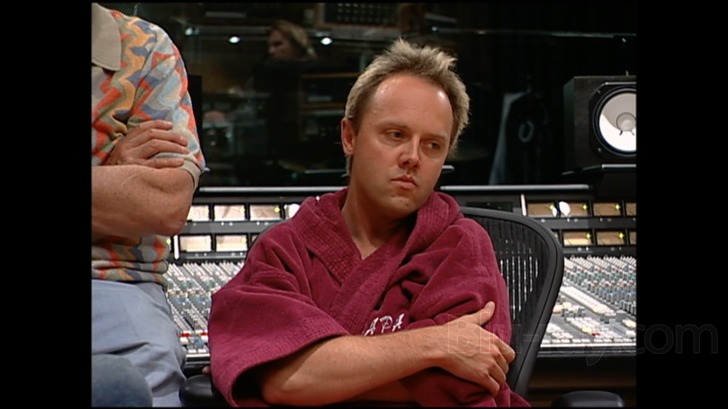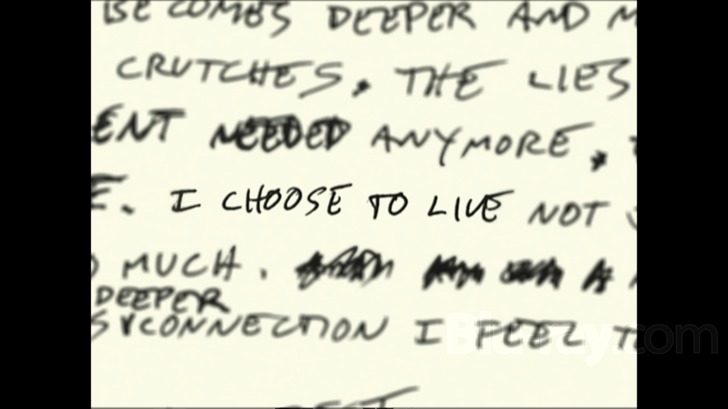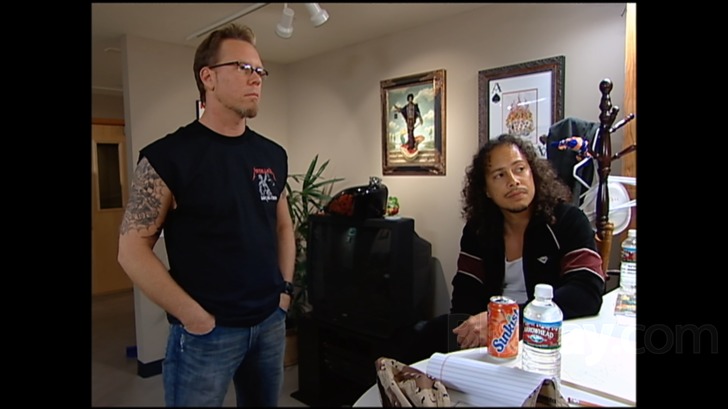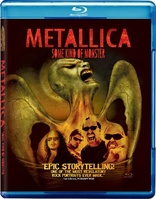Metallica: Some Kind of Monster Blu-ray Movie
HomeMetallica: Some Kind of Monster Blu-ray Movie 
Blackened Recordings | 2004 | 141 min | Rated R | Nov 24, 2014Movie rating
7.4 | / 10 |
Blu-ray rating
| Users | 0.0 | |
| Reviewer | 4.0 | |
| Overall | 4.0 |
Overview
Metallica: Some Kind of Monster (2004)
A documentary crew followed Metallica for the better part of 2001-2003, a time of tension and release for the rock band, as they recorded their album St. Anger, fought bitterly, and sought the counsel of their on-call shrink.
Starring: James Hetfield, Lars Ulrich, Kirk Hammett, Robert Trujillo, Dave MustaineDirector: Joe Berlinger, Bruce Sinofsky
| Music | Uncertain |
| Documentary | Uncertain |
Specifications
Video
Video codec: MPEG-4 AVC
Video resolution: 1080i (upconverted)
Aspect ratio: 1.35:1
Original aspect ratio: 1.33:1
Audio
English: DTS-HD Master Audio 5.1 (48kHz, 24-bit)
English: LPCM 2.0 (48kHz, 24-bit)
Subtitles
English SDH, Spanish
Discs
50GB Blu-ray Disc
Two-disc set (1 BD, 1 DVD)
Playback
Region A (B, C untested)
Review
Rating summary
| Movie | 5.0 | |
| Video | 3.0 | |
| Audio | 4.5 | |
| Extras | 5.0 | |
| Overall | 4.0 |
Metallica: Some Kind of Monster Blu-ray Movie Review
Reviewed by Brian Orndorf December 1, 2014It started innocently enough: filmmakers Bruce Sinofsky and Joe Berlinger (the “Paradise Lost” documentaries) were called in to document Metallica’s (singer James Hetfield, drummer Lars Ulrich, and guitarist Kirk Hammett) return to the studio to record their new album, which would eventually become 2003’s “St. Anger.” The studio time was booked, the equipment set up, and the helmers ready to capture the creative process. Unfortunately, the band was a mess, having just lost longtime bassist Jason Newsted, while internal friction heated up to such a degree that the presence of Phil Towle, a $40,000-a-month psychologist and “life coach,” was necessary to assist band communication and focus. What was intended as mere months in the studio became over two years of footage. “Some Kind of Monster” chronicles this arduous journey toward metal clarity and patience.

The film opens in 2001, finding Metallica fractured into little pieces due to the loss of their bass player over artistic differences, also suffering fatigue from being one of the biggest bands around. As they enter The Presidio, a former San Francisco military outpost, to record the album, the mood is grim and interpersonal feelings are hostile. The band manages to bang out some songs, but the vibe isn’t correct, and because of newly introduced therapy sessions, the unit walks on eggshells around one another, attempting to express their feelings through their new vocabulary of “I’m OK, you’re OK” communication.
It’s apparent right away that Sinofsky and Berlinger are not going to be capturing an episode of “Behind the Music,” or even the simplistic, frat-boy fun overtones of Metallica’s own stabs at previous documentaries. “Monster” is just that; depicting a time in the band’s life where the pieces of fame, friendship, and musicianship are breaking up, with Towle and producer (and temp bassist) Bob Rock holding Hetfield, Ulrich, and Hammett together so they can create one more album. The camera watches as the trio scrap with one another, each seemingly loathing their new remedial angle of communication, but respecting the results it brings. Unexpectedly, “Monster” also sheds some light on Hetfield and Ulrich’s parenting skills, allowing their kids to be around the recording sessions, and the picture includes a sweet scene following Hetfield as he attends his daughter’s ballet recital.
Months into recording, Hetfield, tired of the band dynamic and his own crippling problems, takes off for rehab, leaving the rest of the team in a lurch for almost a year. This second act of down time without Hetfield begins to probe Ulrich’s perspective -- a man largely considered to be the most publicly hated member of the band due to decades of unfettered ego and his attempts to shut down file-sharing computer program Napster over claims of song theft. The viewer meets Ulrich’s eccentric father, who openly criticizes his son’s music, which visibly irritates Lars. We see the frustration of the drummer watching his beloved band slowly erode, coming to terms with a potential break-up. Finally, in the film’s most revelatory moment, former guitarist (and Megadeth frontman) Dave Mustaine is called into Ulrich’s therapy session to vent his own feelings of anger, regret, and resentment for having been tossed out of the band for drunken behavior back in 1982 (this coming from a band who were commonly referred to as “Alcoholica”). For Metallica fans, this moment is incredible, providing some much needed closure. For the rest of the audience, the scene is indicative of the entire feature, which is fearless in displaying the emotional abysses the band is facing, using unbelievable access to capture these moments of the metal gods on their knees begging for emotional clarity and forgiveness.
Eventually, Hetfield returns and the band goes back to work. But restraints on the creative process due to Hetfield’s rehabilitation rules threaten to topple Metallica once again. The reemergence of Hetfield as a clean living, introspective person is fascinating to watch, and the filmmakers make sure to remind the audience of what his life was like pre-rehab, presenting archival footage of a beer-swilling singer shoulder-deep in anger and control issues. The new, cautious Hetfield almost seems like a robot by comparison. It’s interesting to see the two sides constantly at war with each other throughout the movie.
And Kirk Hammett? An integral part of the band since the “Kill ‘Em All” years, the free-spirited, new age-ish Hammett has learned well how to survive under the thumb of Hetfield and Ulrich, either keeping his nose out of their business or desperately trying to play peacemaker as he walks carefully through the minefields the years have planted in the band’s dynamic. His best moment comes when Rock suggests that Hammett’s complicated solos should take back seat for the new album, triggering panic in the guitarist, who fears his only connection to the Metallica sound will be severed, possibly forced out of the unit like Newsted was.
The final subplot that Sinofsky and Berlinger weave throughout the picture is the presence of Towle, who comes close to rivaling Eugene Landy in his attempts to latch on to this sugar daddy of a band. At first, Towle is a necessity for communication, dragging honesty and respectful tones out of the band members. However, as soon as Hetfield takes it upon himself to clean up his act, Towle’s role becomes obsolete, which he refuses to recognize, even going so far as to make plans to move from Kansas to the Metallica headquarters in San Francisco to permanently set up shop. Scary stuff. The filmmakers slyly showcase the argument against Towle’s involvement throughout the movie, ending with Hetfield’s not-so-joking questioning of the therapist’s desire to join the band.
Metallica: Some Kind of Monster Blu-ray Movie, Video Quality 

Retaining the feature's original DV-shot appearance, the AVC encoded image (1.35:1 aspect ratio) presentation is upconverted for this Blu-ray debut, and HD limitations are noticeable, evident in the appearance of jagged edges and haloing. While this isn't nearly the HD powerhouse "Through the Never" was, it looks adequate, with a bright image quality that restores the original look of the effort (if you've only seen the picture theatrically, the loss of its dulled 35mm presentation is a bit jarring at first). Colors are bold and true, with natural skintones and satisfactory primaries. Blacks are communicative but inherently restrained.
Metallica: Some Kind of Monster Blu-ray Movie, Audio Quality 

The 5.1 DTS-HD MA sound mix does Metallica's catalog proud, carefully navigating the picture's mix of bootleg footage and professionally shot video. Conversations and interviews are crisp and true, never tripped up by distortion, remaining comfortable and intelligible in emotional extremes. Music is the big show here, and songs retain their firepower, offering a deep, heavy vibe that celebrates the band's musicianship. Surrounds aren't active, but a few directional moments arrive, and concert sequences keep crowd atmospherics alert.
Metallica: Some Kind of Monster Blu-ray Movie, Special Features and Extras 

On the Blu-ray:
- Commentary #1 features Metallica.
- Commentary #2 features directors Joe Berlinger and Bruce Sinofsky.
- "This Monster Lives" (26:32, HD) initially promises to interview Metallica, Sinofsky (who, due to illness, only participates by phone), and Berlinger on the subject of "Some Kind of Monster" as the band prepares to release a second feature, 2013's "Through the Never." While brief snippets of questioning remain, this is a disappointing short (directed by Berlinger), using interviews collected at the Toronto Film Festival and extensive clips from "Monster" and "Never," almost appearing as an extended commercial for the latter title. Nuggets of reflection remain, and it's interesting to see how everyone has aged, but this is far from a patient, exploratory follow-up.
- And a Theatrical Trailer (3:11, SD) and a Concert Trailer (2:27, SD) are included.
- Additional Scenes offer 28 snipped moments, offering additional peeks at the domestic side of the band, musical collaborations with rappers, studio work, and additional therapeutic encounters. A handful of scenes can be viewed with filmmaker commentary. There is no Play All option.
- Festivals & Premieres travels around America with the band, visiting the Sundance Film Festival, San Francisco Film Festival, the New York premiere, and the Metallica Club screening. There is no Play All option.
- Additional Scenes II provides 13 more deleted moments, including an extended sit-down with Lars and Dave Mustaine, Rob Trujillo's first interview, and additional awkwardness with Jason Newsted. A few of the scenes are accompanied by filmmaker commentary. There is no Play All option.
- Music Video (4:36, SD) for "Some Kind of Monster" is included.
- Filmmaker Bios for Berlinger and Sinofsky are offered.
Metallica: Some Kind of Monster Blu-ray Movie, Overall Score and Recommendation 

More than just a music documentary "Some Kind of Monster" is an open wound that's endlessly fascinating to study, also bringing an essential understanding and needed perspective to the previously disregarded "St. Anger" album. It's an incredible, and incredibly candid, look at band mechanics, and a portrait of psychological unrest that many musical acts wouldn't dare make available to their fans. However, "Some Kind of Monster" will even appeal to the non-fans too, through the sheer energy of toxic conflict and the gradual humanization of previously unreachable rock stars. It's a long journey (141 minutes), but riveting to the last frame.
Similar titles
Similar titles you might also like

Metallica Through the Never
2013

Metallica: Quebec Magnetic
2009

Metallica: Orgullo Pasión y Gloria: Tres Noches en la Ciudad de México
2009

The Beatles: Eight Days a Week - The Touring Years
Deluxe Edition | ~90m Bonus disc
2016

U2: Rattle and Hum
1988

The Grateful Dead Movie
1977

20 Feet from Stardom
2013

The Last Waltz
1978

The Big 4: Metallica, Slayer, Megadeth, Anthrax - Live From Sofia, Bulgaria
2010

Metallica: Français pour une nuit
2009

Iron Maiden: Flight 666
2008

The Decline of Western Civilization
1981

Rush: Beyond the Lighted Stage
2010

Gimme Shelter
Uncensored 30th Anniversary Version
1970

The Song Remains the Same
Led Zeppelin
1976

AC/DC: Let There Be Rock
1980

Springsteen & I
Bruce Springsteen
2013

Shine a Light
The Rolling Stones
2008

Depeche Mode: 101
1989

Elvis Presley: Elvis - Aloha From Hawaii Via Satellite
50th Anniversary
1973
